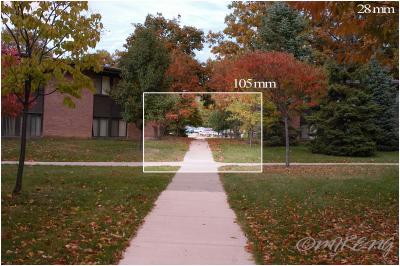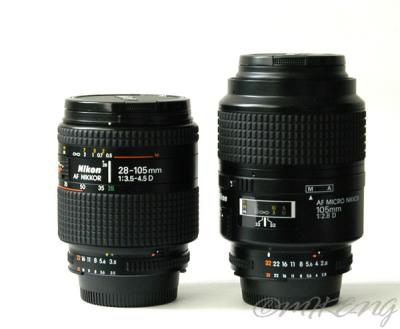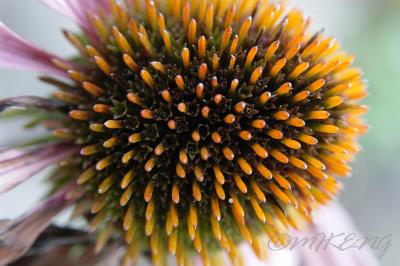





 |
 |
 |
 |
 |
 |
| Michael Ng | profile | all galleries >> Photo Gear & Reviews >> Nikon 28-105mm f/3.5-4.5D AF | tree view | thumbnails | slideshow |
|
This lens was introduced together with the Nikon F100 in 1999. As a result, many considered this lens as the “kit lens” for the Nikon body. Unfortunately due to the release of Nikon’s release of numerous normal zooms and the introduction of AF-S and VR technology, this gem of a lens is often overlooked. |

|
Lens Specifications: Lens Construction: 16 elements in 13 groups (1 Aspheric) Picture Angle: 74 degrees 20 minutes-23 degrees 20 minutes (35mm format), 53 degrees-15 degrees 20 minutes (Nikon DX format) Minimum Focus Distance: 1.7 ft. Maximum Reproduction Ratio (Macro Setting): 1:2.74 Attachment/ Filter Size: 62mm Dimensions (diameter x length - in.): 2.8 x 3.2 in. Weight (oz.): 16 oz. Nikon Lens Hood: HB-18 Case(s): CL-49 Included Accessories: 62mm lens cap, rear cap New Price: USD$324.95 Used Price: USD$140-200 (mint) |
 The macro switch. |
Introduction: After shooting primarily with both my 17-35mm and 70-200mm, I was looking for a lens that would fill in the focal length gap between the two. Both those lenses were great for my digital applications, but I realized that I wouldn’t be well covered if I had to shoot with my F100 film body. After debating between getting this lens, the 24-85mm f/3.5-4.5G AFS or just a 50mm f/1.4D prime, I finally pulled the trigger on the 28-105mm when someone had a unit up for sale at a bargain price. Of course I did some research prior to my purchase. This lens apparently gained the nickname of “swiss army knife” because of its versatility. This comes to no surprise as it has a generous zooming range (28-105mm) and it even features a 1:2 macro reproduction ratio! I found Nikon’s specs for this lens to downplay it quite a bit. It’s really 1:2 and not 1:2.74 as mentioned on the specs sheet. Reviews also suggested that his lens is a lot sharper than what you’d expect from a “slow” consumer level lens. So I thought I’d give it a go. The lens arrived nicely packed in its box. I was really surprised at how small the box was and consequently pleasantly surprised at how compact this lens was. The construction of the lens was reminiscent of my very first Nikkor lens; the 35-80mm AF. Basically, it was a no-frills solid metal barrel design. I absolutely loved it despite not having the fancy Nikon crinkle finish. |
 The entire zoom range of the lens.
The entire zoom range of the lens. Sizing up against the Nikon 105mm f/2.8D Micro.
Sizing up against the Nikon 105mm f/2.8D Micro.
|
Handling: I mounted it on my D100 and boy, did it feel good. It was compact and light. Almost the perfect travel lens. I say almost because as I looked through the viewfinder and zoomed through the whole focal range, I was disappointed to find the 28mm end a little too long for my liking. This was a classic example of what the 1.5 digital crop factor takes away from some lenses. On film, this lens in my honest opinion is king. But for the purpose of testing out the lens and getting immediate feedback on the image quality, I went out shooting with it mounted on my DSLR. The first thing I noticed about this lens is how quick the AF was. Even on my D100’s aging CAM900 module, AF was quick and quiet. Not AF-S silent, but quiet enough to make me wonder if I really needed it for this lens. On a F100, with a CAM1300, the lens focuses even faster letting out a cute little “chirp” sound as it locks in focus. I believe that the reason is that the focusing range of this lens is incredibly short. To focus from its non-macro minimum focusing distance (0.5m) to infinity (inf) one has to turn the focusing ring only a tiny bit. This may be a little confusing to some so disregard it. Bottom line, is that it focuses really quick. The lens features IF technology, which means that it focuses internally and the lens does not protrude out as it focuses. The front element does not rotate when focusing, which is great when using polarizing filters. Unfortunately, the same cannot be said about zooming. When zooming, the lens elongates and the front filter threads rotate. This may be a minor peeve to some, but generally it is non-issue. |
 Test of the lens' macro capability.  Up close and personal with the moth.  The lens produces pretty good bokeh. |
Macro: The macro mode for this lens is really an added bonus and probably the biggest selling point of this lens. There is a macro switch to enable close focusing, and it can only be activated when the lens is set at the focal lengths between 50mm and 105mm. This feature may take a little getting used to. I tried getting the maximum macro reproduction possible and discovered that this lens focuses really close! The at the 105mm setting you can focus as close as about 3cm which really means that photographing skittish bugs are out of the question. Once again, the Nikon specs are erroneous unless they are referring to the minimum focusing distance without the macro mode. For the image of the moth, my setup was right on top of it. It’s just amazing how I managed to get that much into the frame being literally in touching distance of my subject. I was really fortunate to have a subject who wasn’t too afraid of my presence. But after squeezing out a few frames, he decided that I wasn’t doing him any favors and disappeared into the mass of leaves and stems. Performance: The images produced by this lens were pretty sharp. I wouldn’t say prime lens sharp, but definitely better than what you’d get from a regular consumer (as opposed to pro-sumer) level lens. Despite not having any ED elements, color rendition was accurate and was slightly warmer than my 105mm f/2.8D Micro Nikkor. I didn’t get to shoot a brick wall, so I’m not too sure about distortion. But from my other test images, it seemed non-existent. In other words, it should be the least of your worries. Having nine aperture blades boasting smooth out of focus elements is also a major selling point of this lens. I found this to be true from my trial images. Bokeh was pleasing and smooth, which made subject isolation effective. Conclusion: Since its introduction, this lens had picked up quite a reputation of being the best bang for buck zoom lens in Nikon’s arsenal. It’s got a great focal range, great optics, nice bokeh and a macro mode to boot for US$284.95 after rebate…it’s no wonder. Unfortunately the focal range may be a bit long for digital users to qualify this lens to be the perfect all-rounder lens. Film users on the other hand can rejoice as this lens in my honest opinion is probably the best travel lens you’ll find in the market today. ©Michael Ng 2005 |
If you enjoyed reading this review and would like to support this site, please make a purchase through my recommended retailers via the links below. It costs you nothing extra but allows me to keep these reviews available to the public for free. Thanks! |
|
Or make a contribution: |
| comment | share |
| Guest | 01-Mar-2014 10:54 | |
| Guest | 03-Mar-2011 18:57 | |
| GaleriaFotoStefan | 22-Apr-2010 16:17 | |
| Guest | 09-Jun-2008 15:06 | |